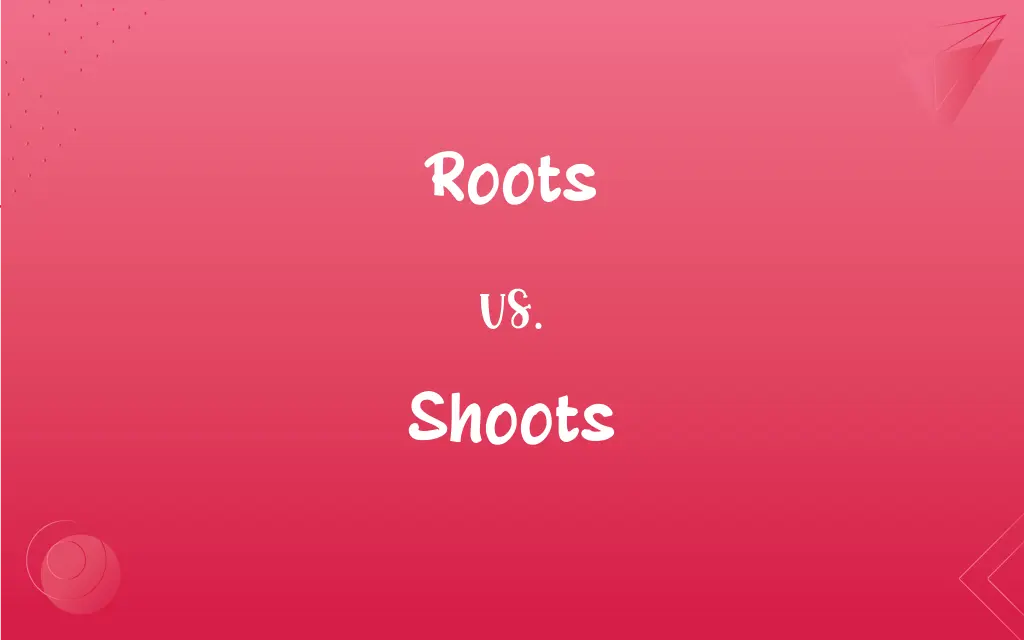Roots vs. Shoots: What's the Difference?
Edited by Aimie Carlson || By Janet White || Published on December 30, 2023
Roots are the underground part of a plant that absorbs water and nutrients, while shoots are the above-ground parts, including stems and leaves, vital for photosynthesis and growth.

Key Differences
Roots are the plant's anchor, securing it in soil and absorbing water and essential minerals. Shoots, in contrast, grow upwards, seeking light and air, consisting of stems, leaves, and reproductive parts.
Roots typically grow in darkness, hidden from view, and specialize in nutrient and water uptake. Shoots are exposed to light, critical for photosynthesis, the process by which plants produce food.
Roots are designed to spread horizontally or vertically in soil, while shoots exhibit versatility in growth direction, often responding to light sources. This phenomenon, known as phototropism, is exclusive to shoots.
Roots often store food and nutrients, providing a reservoir for the plant's growth and survival. Shoots, on the other hand, are where most of the plant's growth occurs, using the stored energy from roots.
Roots lack the chlorophyll found in shoots. This pigment in shoots enables them to capture light energy for photosynthesis, a capability absent in roots.
ADVERTISEMENT
Comparison Chart
Function
Absorb water and nutrients
Support leaves, flowers, and conduct photosynthesis
Location
Underground
Above ground
Growth Direction
Downward or horizontally
Upwards, towards light
Presence of Chlorophyll
Lacks chlorophyll
Contains chlorophyll
Role in Photosynthesis
None
Primary site of photosynthesis
ADVERTISEMENT
Phototropism
Not affected by light
Grows towards light
Storage
Store food and nutrients
Use stored energy for growth
Roots and Shoots Definitions
Roots
Roots are the part of a plant that typically lies below the surface of the soil.
The oak tree's roots extend deep into the earth.
Shoots
Shoots are the new growth from a plant, including stems, leaves, and sometimes flowers.
In spring, the garden is full of new shoots.
Roots
Roots can refer to the basic cause, source, or origin of something.
Understanding the roots of the conflict is essential for resolution.
Shoots
Informally, to shoot can mean to rapidly and informally speak or ask questions.
Go ahead and shoot; I'm ready to answer your questions.
Roots
In family lineage, roots refer to one's ancestry or origin.
She explored her family tree to understand her roots.
Shoots
To shoot is to fire a bullet or arrow from a weapon.
He learned to shoot a bow and arrow at camp.
Roots
In mathematics, a root is a solution to an equation.
The square root of 16 is 4.
Shoots
In photography or film, to shoot means to capture images or footage.
They plan to shoot the movie in New York.
Roots
In hair care, roots refer to the part of the hair closest to the scalp.
She dyed her hair, but her roots were still showing.
Shoots
In sports, shooting refers to the act of trying to score, like in basketball or soccer.
She shoots and scores the winning goal!
Roots
The usually underground portion of a plant that lacks buds, leaves, or nodes and serves as support, draws minerals and water from the surrounding soil, and sometimes stores food.
Shoots
To hit, wound, or kill with a missile fired from a weapon.
Roots
Any of various other underground plant parts, especially an underground stem such as a rhizome, corm, or tuber.
Shoots
To remove or destroy by firing or projecting a missile
Shot out the window.
FAQs
Are roots visible above ground?
Typically, roots are not visible as they grow underground, but some plants may have aerial roots.
Can shoots perform photosynthesis?
Yes, shoots contain chlorophyll and are the primary sites for photosynthesis in plants.
Can roots store food?
Yes, roots can store food and nutrients for the plant.
Do shoots grow towards or away from light?
Shoots grow towards light, a process known as phototropism.
Are shoots involved in water absorption?
No, shoots do not absorb water; this is primarily the function of roots.
Are roots always underground?
While most roots grow underground, some plants have roots that grow above ground.
Do shoots grow throughout the year?
The growth of shoots depends on the plant species and environmental conditions.
What parts of a plant are considered shoots?
Shoots include stems, leaves, buds, and flowers of a plant.
Can roots sense gravity?
Yes, roots exhibit gravitropism, growing in response to gravity.
Are shoots edible?
Some shoots, like bamboo shoots and asparagus, are edible.
What are roots primarily responsible for in plants?
Roots are mainly responsible for absorbing water and nutrients from the soil.
Can shoots be used for reproduction?
Yes, some plants can reproduce through shoot cuttings.
Are the leaves part of a plant's shoots?
Yes, leaves are a part of the shoot system of a plant.
Do roots contribute to plant stability?
Yes, roots anchor the plant in the soil, providing stability.
Do shoots have a role in a plant's reproduction?
Yes, shoots often bear flowers and fruits, which are crucial for reproduction.
How do roots take in nutrients?
Roots absorb nutrients dissolved in soil water through root hairs.
Do shoots have a protective function?
Some shoots, like thorns, provide protection to the plant.
Can roots affect the structure of soil?
Yes, roots can influence soil structure and stability.
Can the roots of a plant affect its surroundings?
Yes, roots can affect soil composition and interact with other organisms in the soil.
Do all plants have roots?
Most plants have roots, but some water plants may have root-like structures instead.
About Author
Written by
Janet WhiteJanet White has been an esteemed writer and blogger for Difference Wiki. Holding a Master's degree in Science and Medical Journalism from the prestigious Boston University, she has consistently demonstrated her expertise and passion for her field. When she's not immersed in her work, Janet relishes her time exercising, delving into a good book, and cherishing moments with friends and family.
Edited by
Aimie CarlsonAimie Carlson, holding a master's degree in English literature, is a fervent English language enthusiast. She lends her writing talents to Difference Wiki, a prominent website that specializes in comparisons, offering readers insightful analyses that both captivate and inform.






































































